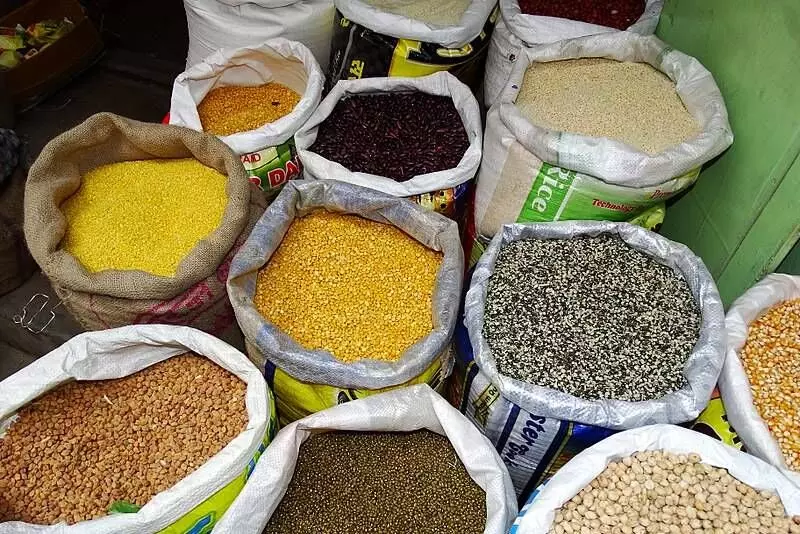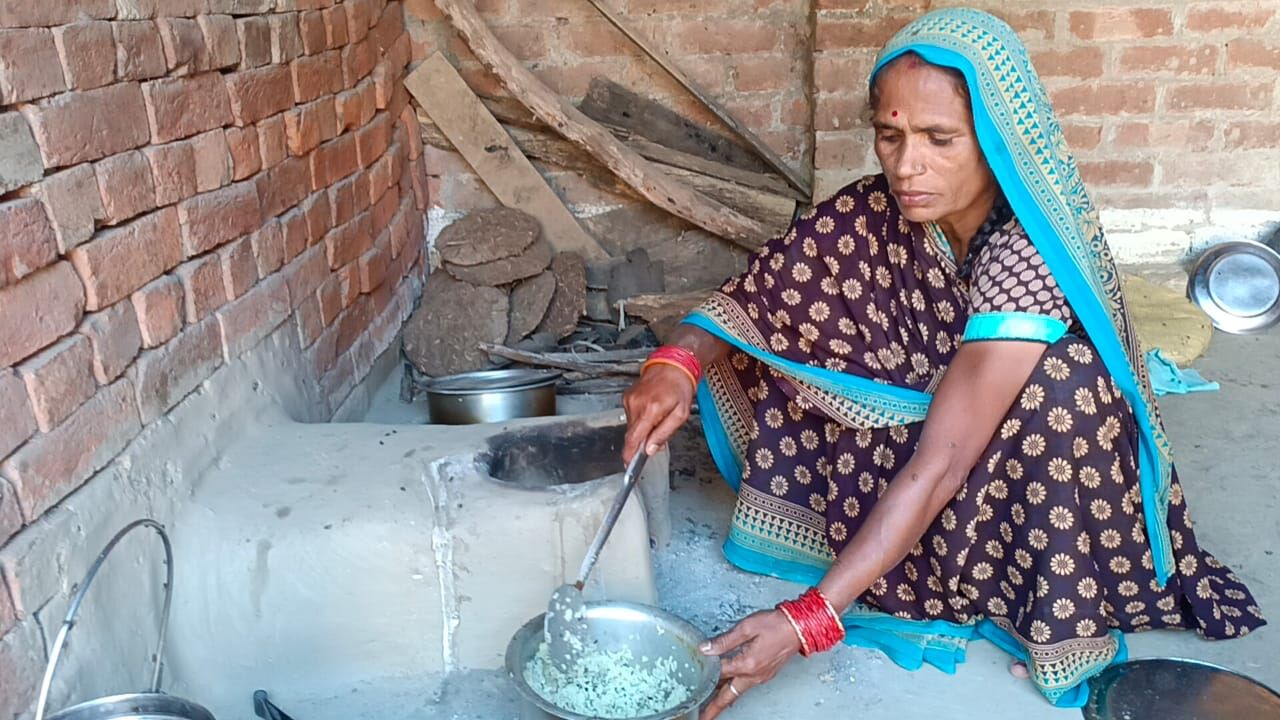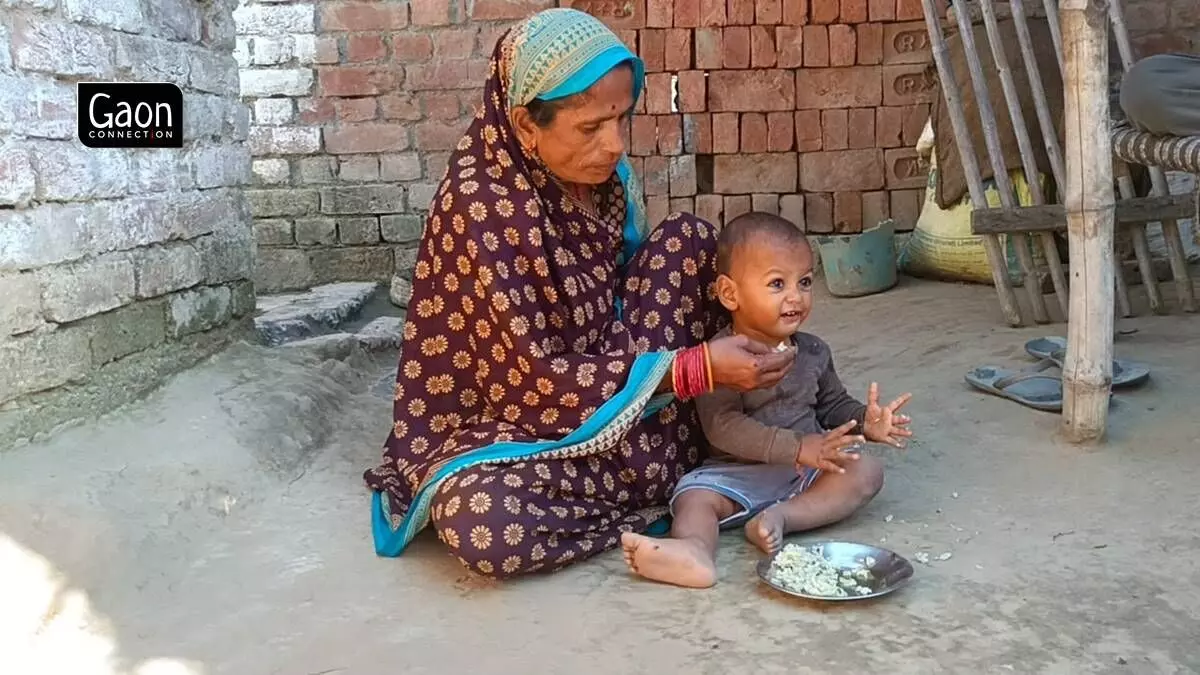In the festive season of Diwali, pulses have become a luxurious commodity for families living in rural India, so precious that people are gifting them to each other.
Pyari Devi, a 60-year-old resident of Paina Buzurg village in Shahjahanpur district, Uttar Pradesh, said with pride how her daughter in law always brings back pulses from her maayka every time she visits her parents.
“My bahu recently brought arhar dal from her mother’s place. Her parents send pulses as a mark of respect. Earlier, it used to be dry fruits but pulses are as luxurious as dry fruits now,” Pyari Devi told Gaon Connection.
But not everyone can afford pulses as a gift because prices of arhar, chana, moong, masoor dal and several other everyday food items have jumped in the past one year.

Pyari Devi, a 60-year-old resident of Paina Buzurg village in UP’s Shahjahanpur district. She mostly cooks potatoes, rice and chapatis. Pulses are a rare addition to her meals. Photo by Ramji Mishra
“My wife dilutes the dal and subzis as much as she can to stretch a meal,” said Insaan Khan, a 55-year-old farmer from Jamuniya village in Shahjahanpur district, Uttar Pradesh. Khan worried about the sharp rise in the prices of food.
Also Read: India Ranks 111 Out of 125 Countries In the Global Hunger Index 2023
“Onion is sold at seventy rupees a kilogram, tomatoes are for Rs 40 per kilo, garlic is Rs 250 a kilo, what else can my wife do… Phal to keval mareez kha sakte hain [only the sick can have fruits]. People like me can never afford to buy fruits. We can only afford potatoes and some rice,” he lamented.
When Gaon Connection asked Amrit Bhuiya the last time he purchased a fruit to eat, the farmer from Kadodiha village in West Singhbhum district of Jharkhand replied: “I ate mangoes in June, this year. That was the last time I had a fruit.”
Bhuiya said that he has a guava tree in his backyard and once in a while he and his family enjoy that.
Food is the biggest expense for rural Indians. It consumes a big chunk of their monthly income. To meet the nutritional requirements, as recommended by the Indian Council of Medical Research (ICMR), daily calories intake in rural areas is set at 2,400 calories per person and 2,000 calories in urban areas.
And to consume these baseline calories, Pew Research Centre estimated that an average Indian family is expected to spend 53 per cent of its budget on food in rural areas and 43 per cent in urban areas. But in reality, many rural Indians are spending much more than that.
Sanjeev Kumar, a 33-year-old daily wage worker, and his brother together earn about Rs 20,000 a month. They live in Khanpur village in Shahjahanpur district and have 12 mouths to feed.
“We need at least 700 grams of pulses, two kilos of rice, and two kilos of wheat flour a day. Then there is oil and cooking gas too. We spend about Rs 500 a day on food alone for the twelve of us,” said Sanjeev Kumar. This comes to about Rs 15,000 a month on food alone, which is 75 per cent of their monthly joint income.
Also Read: “We eat roti with salt”: High inflation has shrunk the food basket of rural Indians
Obviously, that leaves Sanjeev Kumar and his brother with nothing much to spare or save. He said they were cutting down on the consumption of dal and other ‘luxury’ food items; dal was the most expensive commodity, he added.
Not too far from Kumars’ house, Ashok Maurya runs a grocery shop. He lamented that despite the festive season, there was no hike in his sales.
“The arhar dal, which is most commonly used in Indian households, costs almost twice what it did. It was Rs 100 a kilo about a couple of months ago, now it is Rs 170,” Maurya told Gaon Connection.
“Urad dal that was Rs 110 last month is now Rs 130 per kilogramme. Moong dal has gone up to Rs 120 a kilo from Rs 80. Mustard oil is now Rs 250 per litre, it used to cost Rs 200 till last month,” the shopkeeper said.

According to the Union Ministry of Statistics and Programme Implementation, the inflation in rural India is more than its urban areas. A press statement issued on October 12 stated that the consumer price index in urban India rose by 4.65 per cent in September. In rural areas it was 5.33 per cent. And the food inflation in rural India stood at 6.65 per cent.
Last year, in the month of September, the inflation was higher but the situation is worse this year as many villagers have used up their savings.
“Last year, till December, we were getting free wheat and rice from the government [Pradhan Mantri Garib Kalyan Anna Yojana] but that scheme has stopped. We have been buying our cereals now. When labourers like me can’t find work, we have to spend money from our savings. Since last year, whatever savings I had, are spent now,” said Gunjan Kumar, a labourer from Shankhwar village in Shahjahanpur. Kumar has two other brothers living in the household but they are not earning yet.
Also Read: 8 out of 10 Indian households faced food insecurity last year despite free ration relief: Survey
“I get a daily wage of Rs 300 but I cannot find work for more than ten days in a month. My family eats potatoes daily and I don’t remember the last time I had dal,” Gunjan Kumar told Gaon Connection.
His mother, Nirmala Devi said with the Rs 3,000 her son earns in a month, the family can only afford potatoes, rice and roti.

Nirmala Devi has to often force the children to eat the poor quality food when they did not want to. Photo by Ramji Mishra
“Even that has to be cooked on a chullah for which I have to collect firewood. We eat roti with chutney or boiled rice mixed with a little salt and chillies to make it edible,” Nirmala Devi complained to Gaon Connection. She was upset that she had to often force the children to eat the poor quality food when they did not want to. “We understand mehengaayi [inflation], the children don’t,” she said.
In the neighbouring state of Madhya Pradesh, similar stories surface. Devendra Purohit, who works as a daily wage labourer in Rajgarh said that he has cut his consumption of pulses by half.
“My family of four used to consume four kilogrammes of pulses in a month but now I have reduced it to two kgs. I buy arhar dal for daily consumption but ask my wife to dilute it as much as she can,” he said.
Villagers complained of not being able to buy vegetables either. “The menu is the same for dinner and lunch every day. Nobody in the village buys vegetables from the market. We only eat what we grow. Mostly we eat sarson [mustard] leaves by boiling it and adding salt to the boiled leaves,” said Susaran Purty of Ulihatu village in Khunti district, Jharkhand.
Shopkeepers and traders are worried too.
“People are no longer buying pulses. Even the festival season has not seen a surge in buying. My daily sales used to hover around Rs 15,000 but now it is reduced to Rs 8,000,” Afroz, a grocery shop owner in Mooda Harish village in Shahjahanpur (UP), told Gaon Connection.
“Presently it is available from Rs 80 to Rs 100 per kilogram. They are far more expensive in other states but it is grown locally so the prices aren’t that high here. Shopkeepers like me don’t stock pulses all the time as villagers don’t use pulses daily,” Rajendra Sharma, a shopkeeper in Karampada town of West Singhbhum, told Gaon Connection.
Impact of protein-deficient diet on health
According to a research study titled Assessing the rural food environment for advancing sustainable healthy diets: Insights from India, India’s rural population is losing access to protein-rich food and is increasingly turning to packaged sugary edibles, only because they are cheaper, have a longer shelf life and more easily available than fresh produce.
The study which was conducted on the rural households in Telangana concluded that rural Indians now eat more carbohydrates because they are more affordable and more convenient than trying to source limited protein and micronutrient rich options.

Satish Gadi, a Gurugram-based physician, who has retired from the Indian Army and has served as the Chief Medical Director of the Indian Railways, pointed out that not consuming a protein rich diet and missing out on essential micronutrients can lead to serious health effects.
“People in rural India are mostly farmers, labourers and workers who do excessive hard work in the field and need a far more nutritious diet as compared to the urban residents. Not having a nutrition rich diet can cause a host of health problems like cardiac issues, diabetes, and lead to a premature death,” Gadi told Gaon Connection.
Also, a 2017 survey showed that 73 per cent of Indians are deficient in protein while above 90 per cent are unaware of the daily requirement of protein.
Also Read: Here’s Why Iron-Fortified Rice Has Caused Logjam in Punjab’s Mandis
“Indian diets are predominantly cereal-based, and 60 percent of protein is derived from cereals that have poor digestibility and quality,” an October 2020 article published by Observer Research Foundation, a Delhi-based think tank, mentioned.
Also, a 2018 study highlighted that India has the lowest average protein consumption (at 47 gm per person per day) as compared to other Asian countries as well as developed nations.
Demand to include pulses in public distribution system
Balram, a Jharkhand-based activist working for the Right To Food campaign told Gaon Connection that there is a long standing demand to include pulses and legumes in the public distribution system (PDS).

Last year, till December, the villagers were getting free wheat and rice from the government but that scheme has stopped now.
“The government will have to provide pulses to the rural residents or else malnutrition will increase multifold. The pulses are so expensive these days that even city dwellers can not afford them daily,” he said.
Raj Shekhar, a Delhi-based national convener of Right To Food said that the government is subsidising cereals in the PDS which are already quite cheap.
“The wheat and rice don’t cost much. They are sold for Rs 20-Rs 35 per kilogramme across the country. Even if the government doesn’t subsidise these prices, the underprivileged sections of the population can afford them. The need of the hour is to subsidise pulses as they are the easiest source of protein for the population.
Written by Pratyaksh Srivastava. With inputs from Ramji Mishra in Shahjahanpur (UP), Virendra Singh in Barabanki (UP), Manoj Choudhary in Jharkhand, and Abdul Wasim Ansari in Rajgarh (MP).


















